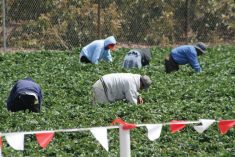When Edith Wearmouth thought of all the reasons why she loved the land her family has farmed for 113 years, it made sense to put part of it into a conservation easement.
“When I was growing up here, I took a lot of things for granted — the creeks and the hills and that sort of thing,” said Wearmouth, who farms with son Travis Eklund and daughter-in-law Kara.
“I was the rancher’s daughter and then I became the rancher’s wife. Then I became the rancher and I started taking note of how ecologically sensitive it was, and started to note the riparian areas and the native grasslands.”
Read Also

Farming Smarter receives financial boost from Alberta government for potato research
Farming Smarter near Lethbridge got a boost to its research equipment, thanks to the Alberta government’s increase in funding for research associations.
Working with Cows and Fish, the family developed plans for a healthy water system and riparian areas at WineGlass Ranch, which is located near Cochrane, one of Canada’s fastest-growing municipalities. But at one point, they thought about relocating their operation, which is home to 300 Angus-cross cattle.
“We were getting a lot of urban pressure,” said Wearmouth. “We get probably five requests a week to come onto the property and do things. We get a lot of requests to sell, and a lot of trespassers.”
But Wearmouth and the Eklunds decided they wanted to stay put.
“We thought, ‘Well, we want to keep this,’” she said. “The Jumpingpound Creek as it flows through here is a major tributary and a major source of water for Calgary.”

More than 23 species of mammals live on the ranch; the creek is home to fish and a spawning ground for the Bow River and; there are many species of birds. The family’s conservation efforts have won numerous awards — including the 1989 Rocky View Master Farm Family Award and the 2004 Environmental Stewardship award from Alberta Beef Producers.
The thought of it being developed just didn’t sit well with them.
“We felt it was very important to keep it healthy, sustainable, and keep it like this,” said Wearmouth. “We didn’t know how we were going to do it. We’ve been thinking about this for quite a few years.”
Eventually, they approached the Southern Alberta Land Trust Society (SALTS) and worked out an agreement. The conservation easement will preserve some grasslands, forests, and riparian areas along the Jumpingpound Creek — 1,247 acres in all.
“The conservation easement will provide that extra level of protection that the land will stay as grasslands and ranching land for the long term,” said Wearmouth.
“You give up the right to sell the land for development, to keep it as it is, because it’s the right thing to do.”
The trust is a federally registered charity that works with landowners who want to see their land stay undeveloped and are willing to agree to the easement’s restrictions, said Justin Thompson, executive director of SALTS.
“Those restrictions typically involve limiting subdivisions, roads and development properties,” he said. “If it’s a ranch that is under pressure to be sold off in small pieces, we can do the conservation easement which limits development.”
Drawing from a provincial fund created with proceeds of Crown land sales, SALTS compensates the landowner with a charitable receipt.
“WineGlass decided over the long term that they didn’t want to see the ranch converted into housing, so they decided to do a conservation easement, so the ranch will stay effectively as a ranch long term,” said Thompson.
A conservation easement is on the title in perpetuity but is structured so current or future owners can do non-ranching activities such as ecotourism, agritourism, or things such as equestrian lessons.
“Activities other than ranching can take place as long as they don’t compromise the conservation values, and as long as the land doesn’t get carved up,” said Thompson.

SALTS was started 20 years ago by a group of ranchers and landowners in Longview and Pincher Creek who wanted to make sure their land didn’t get developed. Since its inception, the trust has created 40 conservation easements covering more than 20,000 acres from west of Calgary all the way to Waterton Lakes National Park.
But urban pressure continues to increase, said Thompson.
“There’s also more demand from the cities to move into the country and have recreational properties,” he said. “There’s a huge intergenerational transfer between parents and kids right now. And often the land values have gone up so much that it is very hard to transfer those properties between generations.”
But a conservation easement can assist the older generation who have all their equity tied up in land, and may need to sell some to fund their retirement.
“What a conservation easement can do is help the older generation get some equity or value out of the land without having to sell it,” said Thompson.
That has more ranchers and landowners considering a conservation easement — and that’s a good thing, he said.
“Most Albertans don’t realize that some of our most ecologically important areas are actually on private land. A lot of our remaining native grasslands are on private lands. It’s an important piece of the picture when it comes to wildlife habitats and watersheds. It is important that we work with landowners who have these valuable ecological properties.”
















